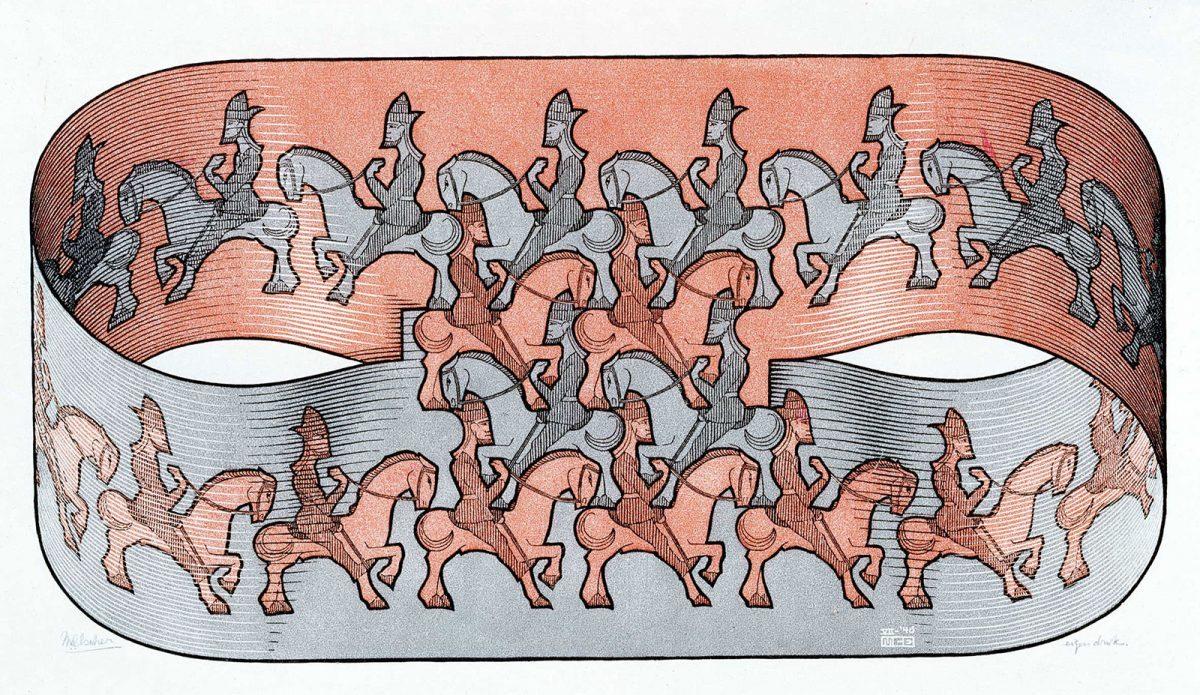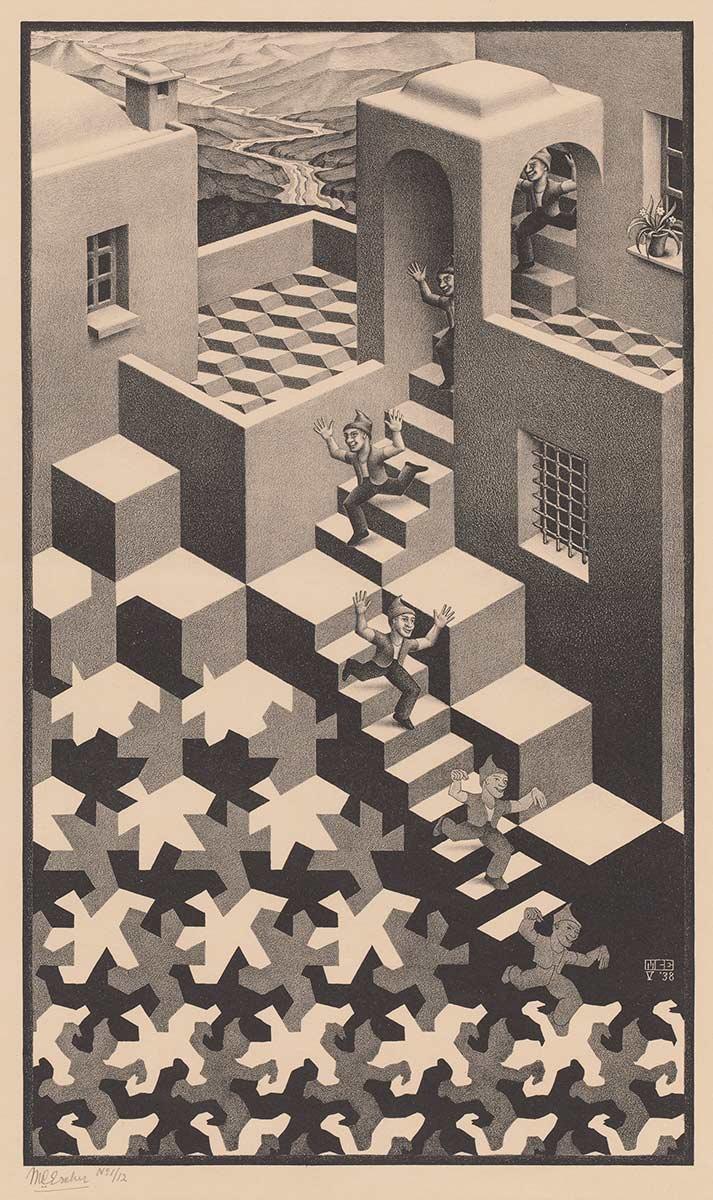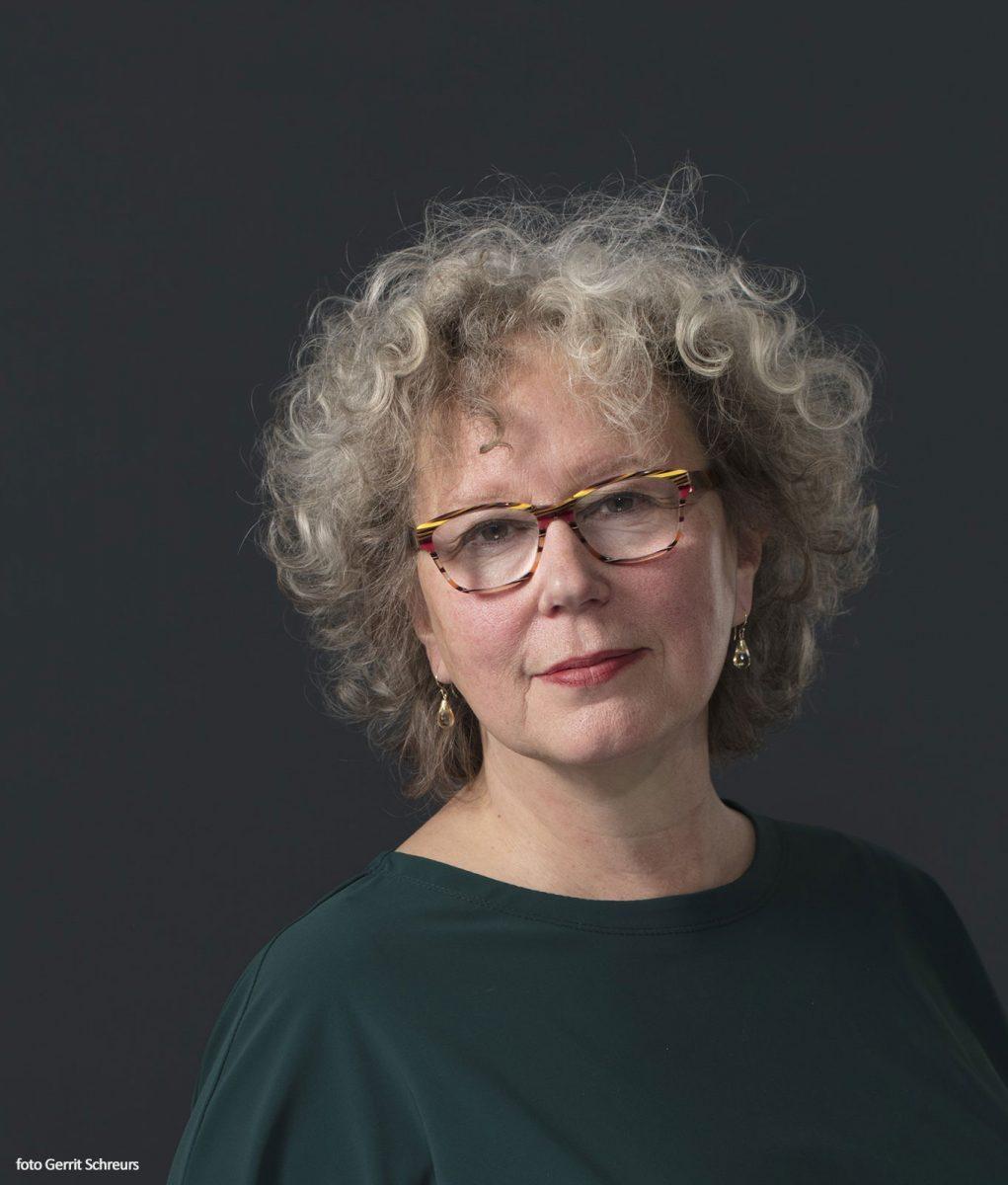
One of the main themes in the work of M.C. Escher is that of perpetual motion: motion that continues indefinitely, generated and maintained by its own momentum. As we have seen in previous stories, Escher was intrigued by the notion of perpetual motion and explored different ways of depicting it in his work.

In Horseman the relationship between the elements of the central section of the print differs from the three-dimensional figure of 8 that forms the basic structure of the Möbius strip. In Horseman the central section of the print is a one-dimensional tessellation. Escher plays with our perception in this section. And this is what initially gives us the impression that we are looking at a Möbius strip.

Möbius I can be pictured as a paper chain link that consists of three stylised fish, each holding the tail of the fish in front of it in its mouth. The eyes of the fish are aligned with the folds in the link. To make it more complicated, the link has been cut in two along its length. It has also been cut along its width and the ends have been twisted and joined together again. See the example above, which is taken from Escher, Magician on Paper by Bruno Ernst.* In Möbius II the Möbius strip is easier to see.
It is no coincidence that in 1961, between Möbius I and Möbius II, Escher completed Waterfall, which shows perpetually flowing water that keeps the water wheel turning indefinitely.
In a revised edition of his book M.C. Escher Grafiek en Tekeningen, which presents his graphic works, Escher himself placed Möbius I and Möbius II in a row of prints featuring strips and spirals. He put Waterfall in the last chapter, together with other ‘impossible constructions’, which is of course where that print belongs. Yet it also contains a Möbius strip-like motion, making it fall into more than just one thematic category.

Escher’s depictions of perpetual motion began with Cycle, an important woodcut in his oeuvre, completed in 1938.

However, in this print, the circular sequence occurs in our mind, rather than us actually being able to see it in the image. The little wall on the left of the print is too much of a hurdle. The later cycles, such as Möbius I and Möbius II, are far more fluid. I would imagine that the Möbius strips, which Escher completed in 1961 and 1963, evolved out of two earlier prints completed in 1955 and 1956, Rind and Bond of Union. In these works Escher also depicts a strip, which he once compared with a strip of orange peel.


Escher sometimes grouped Rind and Bond of Union with other spatial rings and spirals, which include the Möbius strips and other works, such as the Sphere spirals (see below). ** In a set of lectures prepared for speaking engagements in Canada, Escher describes both Rind and Bond of Union as “a hollow image floating through space.” *** In the same lecture Escher also refers to the H.G. Wells story of The Invisible Man. The hero invents a way to make himself invisible, but fails to reverse the procedure. He solves his dilemma by wrapping himself in a bandage. Escher: “This also gave me the opportunity to draw a recognisable portrait with an outside and an inside.”
Two years later, Escher completed the perfect Sphere Spirals in which form and content coincide. If you keep looking at the print, you will see the sphere start to revolve before your eyes.

In 1965 Escher produced Knots. It was a print I couldn’t interpret for a long time. This work obviously belongs with the series of perpetual motion prints. Escher explains that in the print “three unbroken knots are displayed here, that is to say three times over a simple knot has been tied in a cord the ends of which run into each other.”
The perpendicular cross-section of each knot is different. In the top right hand example the profile is round, as in a sausage, in the top left one the profile is cruciform, with two flat bands intersecting each other at right angles; below is a square hollow pipe with gaps through which the inside can be seen (Note the similarity with Rind and Bond of Union). If we start at any arbitrary point and follow a flat wall with the eye, then it appears that we have to make four rounds before we come back to our point of departure. So the pipe does not consist of four separate strips, but of one which runs through the knot four times.
Speaking of the knot in the top left of the print Escher said: “The knot shown at the top left hand corner is in principle every bit as interesting, but it remains undiscussed here, as the draughtsman hopes to devote a more detailed print to it in the future.”**

In the end nothing came of this. But the Escher archive at Kunstmuseum Den Haag (formerly known as Gemeentemuseum) contains the paper knot Escher constructed as a model for the knot in the top left of the print.


In 2014 the knot was examined and restored for the A Sense of Wonder exhibition, which opened in November. Paper restorer Paul van der Zande was kind enough to photograph the knot for us (see above). Now we can clearly see how Escher arranged the two strips at right angles to each other, and also how he labelled the ends to ensure that the three sections were assembled in the right way. Here we see fiction and reality are beautifully intertwined. When assembled, the paper knot looks just like the knot in the top left corner of the print.
In the Knots print Escher creates the optical illusion of three-dimensional shapes on a flat surface. The movement, another example of perpetual motion, occurs in your mind as you try to follow the surfaces of the shapes. As usual, Escher cleverly combines several different things.

In 2012 a dear friend gave me this gift on the picture above: the large knot in the Knots print, printed in 3D. Fiction has now become a tangible reality.
Anyone who arranges Escher’s prints in a particular order and views them in groups will see how he gradually leads us into a world where anything is possible: strips become faces joined together forever, knots are not knots, because, once again, it is impossible to find a beginning or an end, and water can flow upwards indefinitely. But the most remarkable thing of all is that we, his viewers, accept these impossibilities on trust. Without realising it, we believe our eyes rather than our brain. Our brain should tell us that what we are seeing is impossible. Looking is different from seeing. And art is different from reality. Escher shows us this in his earliest Italian landscapes and he keeps it up to his last prints.
Sources of quotations:
* Bruno Ernst, Escher Tovenaar op papier , Kunsthal Rotterdam, Waanders Uitgevers, Zwolle, M.C. Escher Foundation, Baarn, 1998.
* * M.C. Escher Grafiek en Tekeningen, ingeleid en toegelicht door de graficus , Taschen GMBH 2006 re-edition of the book originally published by Koninklijke uitgeverij J.J. Tijl NV, Zwolle 1959, p.12-15.
*** Escher on Escher Exploring the infinite; with a contribution by J.W. Vermeulen, translated from Dutch by Karin Ford, Abrams, New York 1989, p. 63.
More stories about Escher

The illusion of a Dragon


